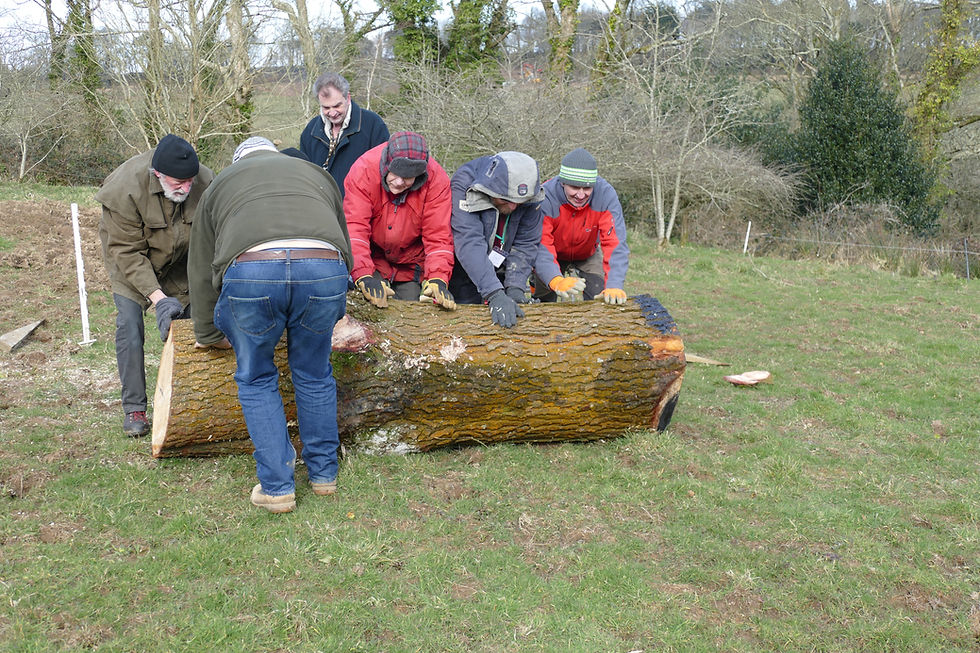The Sunhive goes to Prison
- Natural Beekeeping Trust
- Jul 24, 2015
- 4 min read
Updated: Feb 9, 2020

Eighteen bundles of biodynamic rye straw – cleaned…{tick}
Six stands, starters, frames, spray bottles, scalas…{tick}
Six fids and bodkins…”fids and bodkins! How on earth are we going to get them through security?”
Peter reassures, “ it’s all been OK’d. ”
So it was with a mixture of eager anticipation and trepidation that Peter Brown and I set off for a three-day Sun-Hive making workshop with inmates of Rye Hill Prison. Our arrival proved to be somewhat illusory as the 150 metres from ‘Prison Entrance’ to workshop area seemed to take an age to negotiate, through gate after security gate. Viewing mirrors under our van (among other things) indicated to us that security was a serious business here.
Square brick buildings with small barred windows enclosed by razor-wire perimeter fencing sitting in an uninspiring landscape of arable monoculture. The prison’s wish to place a number of hives within this barren desert was immediately bewildering to us. How will bees survive here? And who will be collecting the swarms from the inevitable cluster points high up on that razor-wire fence? Are ladders even a part of ‘Prison Miscellaneous’?
We finally arrived at our destination and were astonished by the powerful effect of a few joyous cosmos blooms skirting the side of the demountable office/classroom . “We’ll be planting a whole lot more of these”, said our assisting officer with enthusiasm. “See that strip of grass along the perimeter fence? We’ve plans for that too.”
Moments after the van was unpacked the inmates arrived: a motley crew of a dozen or so with a fair amount of ‘argy-bargy’ and banter between them. Rapt attention nonetheless when Peter began his introductory talk.
Already aware to some extent of the plight of Apis mellifera through their impressive efforts in creating and maintaining the small organic garden where the cosmos grow (A project run by the charity Garden Organic), the listeners appeared moved by Peter’s re-telling of the Sun-Hive story. A story about German sculptor, Guenther Mancke, and his tireless pursuit to find a form for a beehive that would be in sympathy with the ‘Bien’ – the hive as a whole organism, and not simply designed around convenience of honey production and harvesting. The Bee lectures of Rudolf Steiner were also alluded to.
“….The bees live in an atmosphere completely pervaded by love”, Steiner tells us. He also warns of the catastrophic consequences for the bees (and humans as beings dependent on the bees) if such invasive practices as artificial queen rearing and natural swarm suppression were to continue. “He was on the money with that one!” comes a voice from one of the listeners. “I’ll say!” chimes in another.
Peter tells of his first meeting with Gunther Mancke: how he and Heidi Hermann of the Natural Beekeeping Trust offered to bring the sunhive to the UK as an NBKT and Biodynamic initiative. G. Mancke’s book on charting the Sun-Hive’s development and including specifications on how to build the hive would be translated into English and regular hive-making workshops would be run in conjunction with Tablehurst Farm in East Sussex. “The response to the hive has at times been overwhelming”, Peter explained, “and demand for the workshops; invitations to present the hive at events around the country are regular and ongoing. And now … the sunhive goes to prison!”
The eagerness to begin weaving was palpable. And as the workshop progressed and the hives began to take form, so too the atmosphere in the group took form. The process of repetition – fid and bodkin piercing coil, cane threading through, wrap, pull tight, add straw. Repeat. Pierce coil, thread through, wrap, pull tight … Repeat … Repeat … Repeat. A mantra-like meditative state develops. It is calming. Centring. The attention of the inmates on the task in hand is tangible. I found myself humming a traditional Native North American weaving song:
‘Weave and mend, Weave and mend, Gather the fragments safe and mend the Golden Circle …’
Later as Peter and I reflected on the experience, we spoke about the healing potential of the golden circles mending together to form the Sun-Hive. An empty vessel yet, though soon to be offered as a ‘body’ for the ‘Bien’ – that Being so intrinsically connected to the heavenly realms of light, warmth and love. Perhaps the warmth of the ‘Sun’ colony can, in so to say a homeopathic way, re-awaken the cold confines of the prison colony with a mood of wonder and reverence – qualities notably absent from the current cultural mainstream.
According to one contemporary pioneer of holistic and healing agricultural practices, His Royal Highness The Prince of Wales, “We have become dangerously numb to the Sacred.” The inevitable ‘lullaby of materialism’ (Rudolf Steiner) that ensues does not necessarily result in a peaceful and passive sleep. The Rye Hill Prison sunhive makers have been judged to be guilty of heinous crimes. Yet surely they also are victims of a society that has endorsed a near total schism between spirit and matter: heaven and earth.
The individuals involved in creating the organic garden prison project that now incorporates the sunhive initiative must be applauded. It is a small though crucial step towards reigniting our dulled and numbed sense of the sacred.
Daniel Docherty is an artist, geometer and educator. He works at Tablehurst Farm where he also runs regular skep-making and sacred geometry workshops. (www.sacredartofgeometry.com)
This article was first published by Star & Furrow, the journal of the Biodynamic Association
Artwork: Via Docherty





Comments